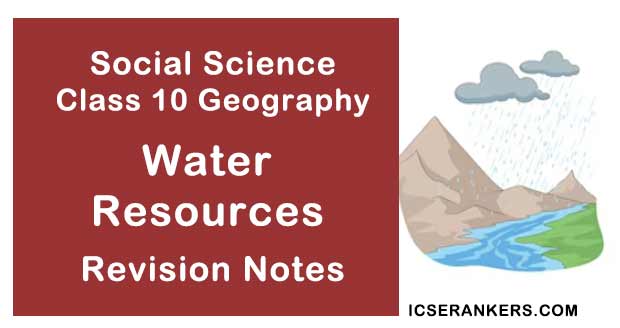NCERT Notes Class 10 Social Science Geography Chapter 3 Water Resources

Chapter 3 Water Resources NCERT Notes
Chapter Name | Water Resources Notes |
Class | CBSE Class 10 |
Textbook Name | Contemporary India Class 10 |
Related Readings |
|
Introduction
This chapter starts with how much freshwater availability on earth and how water scarcity begins. This chapter will understand the advantages and disadvantages of building dams on the rivers. Therefore, we will also be learning about the rainwater as it means saving water.
Water
- Water is nearly three-fourth of the earth’s body, full of water but has a little water left to get fresh water that can be put to use.
- Water is a useable resource.
Water Scarcity and the need for water conservation and management:
The amount of water resources depends on space and time:
- Water scarcity is due to over-flowing, more use, and unequal water amount to various communities.
- The water resources have been over-flowing to make fertile regions for dry-season farming.
- In a few areas, water will be available for people’s needs; therefore, they suffer from wastage in a few other places because the water is terrible.
- We need how on how to save and handle our water resources. Here are the following:
- To keep it safe within ourselves from illness.
- To ensure that the food is secure, it will continue until the lively and productive tasks.
- It will provide the indignity of pristine ecosystems.
Multi-purpose River Projects and Integrated Water Resources Management
During those times, we used to save water by building a confusing hydraulic structure such as dams created by stones, rubble, reservoirs, dams, and canals for drainage. We have kept this tradition going like modern India by building in a few of our river basins.
Here are a few:
Dams
- A dam is a border in which the water flows across that will create, direct the flow. Therefore, it sometimes builds a reservoir, lake, or impoundment. “Dam” means that reservoir more than the structure.
What is the importance of dams?
Dams are well built:
- Seize the rivers and rainwater can be used later to dissolve the agricultural fields.
- It is used for electricity generation.
- It is used for water supply for domestic and factory uses.
- It can control the flood.
- It is recreated, and it is used for inland navigation and fish breeding.
What are the problems with building dams?
- It keeps on going, and the rivers’ damming will cause their natural flow.
- It has low habitats for the river’s aquatic life.
- It has a smell in the river, which will make it difficult for the marine fauna to move around.
- Dams built on the flood plains will move on to the old vegetation and soil, leading to decomposition over time.
- Building massive dams will create so many new environmental movements such as the Narmada Bachao Andolan” and the “Tehri Dam Andolan,” etc.
- Many times, the local people gave up on their land, livelihood, and soil, leading to decomposition over time.
Most of the time, with the people who disagree with the projects, their mistakes are to pass the reasons for which they are created. Many dams are built to control floods; hence, these dams have created floods. Dams also have created more damage to soils. More water usage has caused earthquakes, even water diseases and insects, and pollution.
Rain Water Harvesting
Rainwater harvesting is an easy way by which rainfall for further uses. The rest of the rainwater will be saved and used for various ways or straight used for reasons.
Various methods have been developed in different regions for rainwater harvesting:
- In Hills and mountain regions, people have structured different channels such as the guys or kills of the western Himalayas for farming.
- The rooftop rainwater harvesting is mostly used to save drinking water, especially in Rajasthan.
- During the flood plains in Bengal, people build flood channels to solve their fields.
- In arid and semi-arid areas, the agricultural fields are switched into the rain-fed storage build that will allow the water to flow and moisten the soil, such as Khadins, from Jaisalmer Johads in various parts of Rajasthan.
- The tanks are a part of a properly developed rooftop rainwater harvesting system; therefore, they are structure inside the main house or the courtyard. These are usually practiced in Rajasthan. In states called Bikaner, Phalodi and Barmer regions, it saves rainwater. There are so many houses built underground rooms next to the “Tanks” to avoid the summer as it can keep the room cold.
